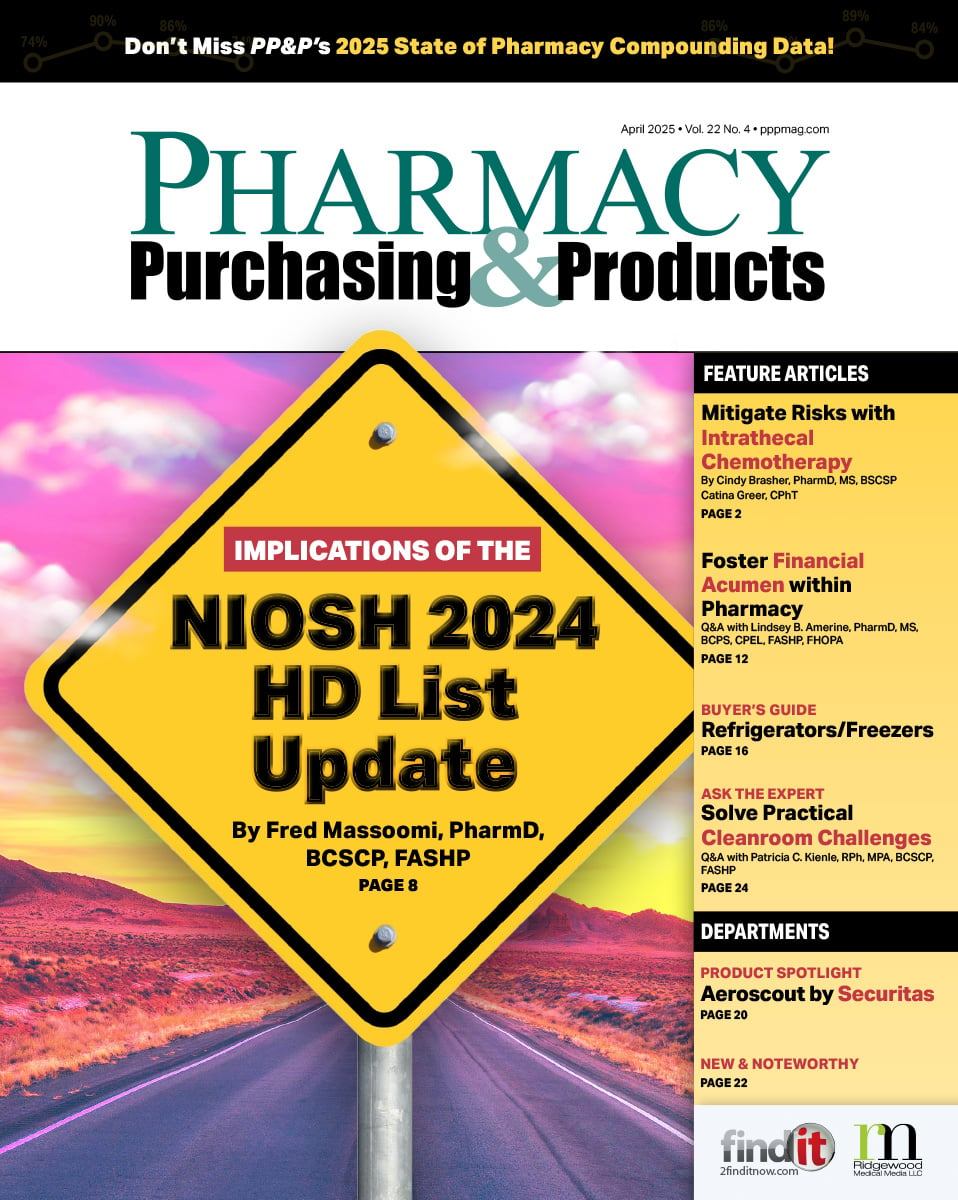- Show Menu
- Contact Us
- FAQs
- Reader Service
- Survey Data
- Survey Winners
- Testimonials
- Upcoming Events
- Webinars
- White Papers
EHR Implementation in an Outpatient Infusion Clinic
For a small pharmacy operation, implementing new technology can have a significant impact on pharmacy workflow. Denver Health (DH), a Level I trauma center and the primary safety net institution in Colorado, provides care to approximately 25% of Denver residents. The outpatient infusion center, located on the DH campus, utilizes 13 infusion chairs and one bed in which patients with gastroenterology, neurology, and rheumatology conditions, and hematologic and solid malignancies, receive intravenous treatment. Approximately 30 patients are treated per day, with one-third of these patients receiving chemotherapy to treat cancer. One out of every six patients receives drug assistance through a manufacturer- or patient-assistance program. The provision of the highest quality health care is an integral part of the DH mission. As such, the patient-to-nurse ratio is 5-6:1, and all of the nurses are chemotherapy-certified through the Oncology Nursing Society.
Our small but busy outpatient infusion center recently adopted a new oncology information system as part of a system-wide upgrade to an electronic health record (EHR). The transition to the EHR and implementation of an oncology information system from paper records has revolutionized drug prescribing in the outpatient infusion center. Prior to this upgrade, all infusion center orders were written on paper, and the pharmacist was responsible for transcribing the order into the pharmacy application to generate a label. Although a double-check system was in place for all chemotherapy orders, the paper system presented challenges, including deciphering unclear handwriting, the existence of duplicate and/or outdated orders, and the accumulation of paper records and patient folders in a non-commodious space.
Implementing the EHR addressed these challenges by facilitating a comprehensive, system-wide interface between DH and its many clinics and nine community health centers, as well as other hospitals within the EHR vendor’s network. Additionally, the oncology information system has vastly improved drug prescribing in the outpatient infusion center.
Managing the Transition
Transitioning to the EHR required significant coordination, staff education, and patience; nevertheless, the progression was smooth. The oncologists, oncology pharmacist, and nurses attended several validation sessions in the months prior to go-live, during which we worked with the oncology information system vendor’s team on a weekly basis to design templates for the most commonly used chemotherapy regimens, both for facility-administered and take-home medications. Given the rapid evolution of the oncology field with new drugs continually entering the market, this process is an ongoing endeavor.
Prescribers were required to transcribe all existing orders from paper into the new EHR. Although other institutions often utilize pharmacists for this task, we deliberately assigned this responsibility to the prescribers. Our goal was to expose prescribers to the system prior to go-live in order to increase their comfort level with the technology. Notably, some prescribers who are less technology-savvy expressed frustration during this process, and continue to do so. Nonetheless, this strategy proved effective overall, as prescribers did benefit from their early exposure to the EHR. In addition, EHR champions are readily available to assist prescribers who have trouble navigating the EHR by providing re-education and retraining, and prescribers frequently call on these champions for problem-solving. If multiple users experience difficulty with a certain aspect of the EHR, this issue may be escalated and revamped to streamline the process.
Strategies to Ensure Success
Understand EHR Nomenclature and Icons
One of the most significant learning curves that must be overcome when using the oncology information system is developing a mastery of the EHR nomenclature. This is especially true for staff members who do not use the EHR on a regular basis. Additional challenges to expect in pharmacy when transitioning to a new EHR are listed in TABLE 1.
Consider that treatment plans apply to patients with cancer, both in the inpatient and outpatient settings, while therapy plans denote outpatient use only. Therapy plans are intended for continuous administration of drugs (eg, weekly iron) or are for patients who receive cytotoxics for reasons other than cancer treatment. For example, the template and process for ordering cyclophosphamide for a patient with rheumatoid arthritis are different than ordering it for a patient with breast cancer.
Other important terminology to understand includes “releasing an order,” “deferring a day,” “cancelling a day,” and “completing a day”:
- A nurse releases an order when the patient is ready for treatment
- A day is deferred when the patient does not meet treatment parameters for a specific day, with the intention of making up that missed day at a later time
- Cancelling a day occurs when there is no intention of giving the treatment at a later time
- Once all orders are released, the day can be completed
Although these terms may seem straightforward, confusion does occur, so it is crucial to ensure that all staff members utilizing the EHR are trained and have a clear understanding of the terminology. For example, if a prescriber accidentally releases an order (which should not occur, as only nurses should release an order), treatment days will not reflect the correct date and the pharmacist will need to adjust the treatment plan. The most inconvenient action can occur when a prescriber or nurse completes a day when the treatment plan orders have not yet been released. In this situation, the oncologist must add another day and reorder all of the orders within that day (including labs, treatment parameters, premedications, hydration, chemotherapy, etc). This has occurred a few times in the inpatient setting on the weekend shift, with staff which who are less familiar with the EHR and oncology information system; the error is recognized when a nurse tries to act on the order but no action can be taken.
Understanding the various icons used in the EHR is also critical, as the differences can lead to confusion. Our EHR uses the following symbology:
- A syringe or bed icon denotes facility-administered medications
- A bed icon is used for labs to be drawn in the inpatient setting
- A house icon indicates take-home prescriptions and labs to be drawn in the outpatient setting
Value of Documentation
Motivating prescribers to document each administered medication’s use is critical to ensuring an accurate EHR. Although nurses are well versed in medication documentation, physicians who may not routinely administer medications may require reminders, which are provided verbally or via email shortly after the medication has been dispensed. The pharmacist can verify documentation by reviewing the individual order or by generating a report. Upon go-live, we transitioned from charge-on-dispense to charge-on-administration, hospital-wide. This change has required continuous vigilance and regular auditing for certain medications and clinics. Medications that require regular auditing include onabotulinumtoxinA for migraines, aflibercept for macular degeneration, and naltrexone extended-release injection for opioid dependence.
Benefits Realized
The EHR has significantly streamlined pharmacy workflow and has introduced important safety checks (see TABLE 2). Before implementation, it could take more than 5 hours for the pharmacist to complete order entry for the next day, as they had to shuffle through all the patients’ folders and paper orders. Now, the pharmacist can perform advanced verification for all signed orders up to 7 days in advance. This window allows staff to get a head start if the schedule is busy on a particular day. All chemotherapy orders that are first-verified wait in a verification queue until the second pharmacist completes the final verification. Any oncology infusion system-trained pharmacist can access these orders from anywhere in the hospital, which significantly simplifies the process. Previously, the pharmacist had to hand-deliver the label and the patient’s chart to the second pharmacist, who would initial the label, indicating that the order had been entered correctly.
The EHR allows the pharmacy technician to bill for waste, use bar code scanning to double-check product selection, manage inventory by viewing upcoming treatments, and monitor a patient’s status (eg, checked-in, waiting for labs, ready for treatment, cancelled, etc). The technician can use this information to decide whether to de-gown and exit the cleanroom during a lull without having to ask the pharmacist.
Particularly useful is the real-time dot system used in the outpatient infusion center schedule to communicate the status of an order between pharmacy and nursing; this workflow improvement enhances order tracking and ensures robust communication. Nurses turn the dot green when IV access has been obtained, labs have been drawn, and all treatment parameters have been met. The pharmacist then reviews the labs and changes the dot to yellow, indicating that the drug is being mixed. Once the final preparation is ready, the pharmacist turns the dot white, indicating to the nurse that the medication is ready. The dot system is also used to indicate hold treatment (red dot), and if the patient did not keep their scheduled appointment (gray dot). Prior to implementing this feature in the EHR, the nurse had to bring a sticker to the outpatient infusion center pharmacy to indicate that the patient was ready for treatment, or verbally communicate to the pharmacist that a patient would not be receiving treatment.
The EHR allows for the quick identification of medication order details, including the prescriber’s credentials, the technician preparing the medication, the verifying pharmacists, the administering nurse, and the time the infusion was started and completed. This information is useful for medication tracking, auditing, and process-improvement opportunities. EHR data can be used to create customized reports to analyze various metrics. For example, a report can be generated to measure the time from when the nurse releases the medication to when the medication is delivered at the patient’s bedside. This information is utilized to evaluate and improve efficiency throughout the infusion center.
Future Directions
Overall, we are pleased with the significant safety benefits and more efficient workflow facilitated by use of the EHR and oncology information system. In the approximately 18 months since go-live, notable strides have been made.
Per our institutional policy, a pharmacist can round a dose within 10% of the ordered dose for drugs that are supplied in single-dose vials. Given the capabilities of the EHR, the pharmacy department hopes to conduct research on the cost savings realized through dose rounding. The vast reporting capabilities of the EHR open the door to other clinical research and cost savings opportunities in the future.

Lindsay Stansfield, PharmD, BCPS, BCOP, worked as a hematology/oncology clinical pharmacist at the Denver Health Medical Center in Colorado when this article was written, and recently started a new position with AmerisourceBergen. She graduated from the University of Colorado School of Pharmacy and completed a PGY2 in oncology pharmacy at the National Institutes of Health. Lindsay’s professional interests include hematologic malignancies and immunology.
TABLE 1
Potential EHR Implementation Pitfalls from Pharmacy’s Perspective
- Alert fatigue
- Careless mouse actions
- Confusing terminology
- Lack of understanding of vendor-specific actions and terms
- Orders entered incorrectly (eg, facility-administered medication ordered instead of a take-home medication)
- Cost
TABLE 2
EHR Benefits from Pharmacy’s Perspective
- Ability to document and bill for waste
- Assistance with inventory management through usage reports
- Automatic dose rounding (if applicable)
- Advanced preparation verification (up to 7 days)
- Bar code scanning
- Access to patient medical records at other hospitals within the EHR vendor’s network
- Consent, imaging, inpatient and outpatient orders, and results all in one application
- Cumulative dose tracking
- Ease of retiming orders
- Incorporation of Tall-Man lettering
- Report generation
- Schedule viewing
- Health information network compatibility
SYSTEMS SCOOP
The Denver Health outpatient infusion center utilizes the following technologies:
- Electronic Health Record: Epic Systems Corporation
- Oncology Information System: Epic Systems Corporation's Beacon
Like what you've read? Please log in or create a free account to enjoy more of what www.pppmag.com has to offer.








